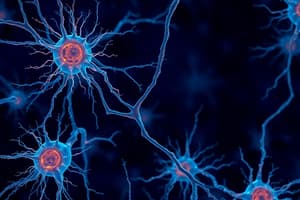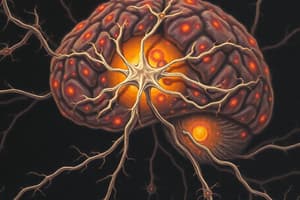Podcast
Questions and Answers
What is the difference between nerves and tracts?
What is the difference between nerves and tracts?
- Nerves are in the CNS and tracts are in the PNS.
- Nerves carry only one type of information, tracts carry multiple.
- Tracts can consist of multiple types of information. (correct)
What are ganglia and where are they located? What is the counterpart to ganglia?
What are ganglia and where are they located? What is the counterpart to ganglia?
Ganglia are clusters of cell bodies of nerves located in the PNS; the counterpart is nuclei found in the CNS.
Astrocytes form the __________ barrier.
Astrocytes form the __________ barrier.
blood-brain
What is the resting membrane potential and how is it maintained? How many ions are exchanged in this maintenance?
What is the resting membrane potential and how is it maintained? How many ions are exchanged in this maintenance?
Describe the activity of the channels in a neuron during an action potential and how is the nerve impulse propagated unidirectionally?
Describe the activity of the channels in a neuron during an action potential and how is the nerve impulse propagated unidirectionally?
What occurs after the action potential reaches the nerve terminal?
What occurs after the action potential reaches the nerve terminal?
What types of receptors are on the postsynaptic membrane?
What types of receptors are on the postsynaptic membrane?
What are the three ways neurotransmitters are cleared from the postsynaptic receptors, and what does clearing them accomplish?
What are the three ways neurotransmitters are cleared from the postsynaptic receptors, and what does clearing them accomplish?
What neurons ascend to the CNS and what neurons exit?
What neurons ascend to the CNS and what neurons exit?
What is a reflex arc and what are the 2 types?
What is a reflex arc and what are the 2 types?
What is white and gray matter, and where is each located in the brain and spinal cord?
What is white and gray matter, and where is each located in the brain and spinal cord?
Flashcards are hidden until you start studying
Study Notes
Nerves vs. Tracts
- Nerves are bundles of neurons in the peripheral nervous system (PNS) that transmit various information types (sensory, motor, or both).
- Tracts are bundles of neurons in the central nervous system (CNS) that carry a single type of information.
Ganglia and Nuclei
- Ganglia are clusters of cell bodies of the same type of neuron located in the PNS.
- Nuclei refer to the equivalent clusters of cell bodies found in the CNS.
Functions of Glial Cells
- Astrocytes contribute to the formation of the blood-brain barrier, regulating substance passage into the brain.
- Ependymal cells line brain ventricles and produce cerebrospinal fluid, providing cushioning and shock absorption for the brain.
- Microglia act as phagocytic immune cells, defending the CNS against pathogens and debris.
- Oligodendrocytes produce myelin sheaths in the CNS, enhancing signal transmission.
- Schwann cells generate myelin sheaths in the PNS.
Resting Membrane Potential
- The resting membrane potential of a neuron is approximately -70 mV.
- This potential is maintained by the Na+/K+ ATPase pump, which moves 3 sodium ions (Na+) out of the cell and 2 potassium ions (K+) into the cell.
Action Potential and Propagation
- During an action potential, potassium channels open at the peak, leading to repolarization.
- The refractory period following an action potential prevents reverse propagation, allowing the impulse to travel unidirectionally along the axon.
Post-Action Potential at Nerve Terminal
- After reaching the nerve terminal, action potentials trigger the release of neurotransmitters from synaptic vesicles into the synaptic cleft.
Postsynaptic Receptors
- The postsynaptic membrane contains ligand-gated ion channels or G protein-coupled receptors that respond to neurotransmitters.
Neurotransmitter Clearance
- Neurotransmitters are cleared from postsynaptic receptors through:
- Enzymatic breakdown.
- Reuptake by presynaptic neurons via reuptake channels.
- Diffusion out of the synaptic cleft.
- Clearing neurotransmitters ceases signal propagation, ensuring precise control of neuronal communication.
Neuron Types in CNS
- Afferent (sensory) neurons ascend towards the CNS.
- Efferent (motor) neurons descend from the CNS.
- Interneurons are the most abundant neuron type, facilitating communication within the CNS.
Reflex Arc
- A reflex arc is the nerve pathway for reflex actions, consisting of at least a sensory neuron and a motor neuron connected by a synapse.
- Monosynaptic arcs involve a single synapse between an afferent sensory neuron and an efferent motor neuron.
- Polysynaptic arcs include one or more interneurons between sensory and motor neurons, allowing for complex reflex responses.
White Matter vs. Gray Matter
- White matter consists of myelinated axons that facilitate rapid communication between brain regions.
- Gray matter contains unmyelinated portions (cell bodies and dendrites) involved in processing and integrating information.
- In the brain, white matter is located deeper than gray matter, while in the spinal cord, gray matter is situated deeper than white matter.
Studying That Suits You
Use AI to generate personalized quizzes and flashcards to suit your learning preferences.





